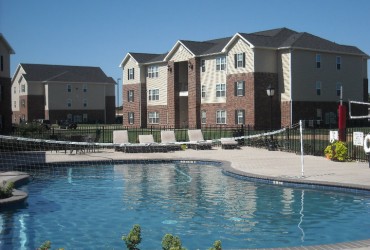When moving, the natural desire is to make the new home seem like the old as much as possible. Couple that with making it a class project, and you have a unique effort ongoing in the Department of Plant and Soil Science.
The expansion and renovation of the Bayer Plant Science Building has required the Department of Landscape Architecture to move its computer lab across the street to the College of Agricultural Sciences and Natural Resources Annex. Landscape architecture interim chairman and associate professor Charles Klein saw this as an opportunity for his materials and details class (LARC 4404) to gain some hands-on experience.
He assigned his fall class to design, plan and renovate the area that sits within the CASNR Annex’s U-shaped design just south of the R-9 parking lot. It is the type of project he, with 30 years of experience in design and build, is familiar with but not something normally part of the landscape architecture curriculum.
“This is the first time we’ve been able to do it, and the smaller class size (12 students) helped make it more manageable,” Klein said. “You don’t have to be out there with 30 students dodging shovels and picks, and it’s also a way to motivate the class by actually being able to create something from a design.”
The only problem is the project might have been a little too ambitious to complete in one semester, Klein said. The harsh winter blast that rolled through the South Plains in early November didn’t help, freezing the ground shortly after the Texas Tech University grounds maintenance crew removed existing grass and concrete. That limited students to get about a third of the way through the construction process.
“This is a materials and details class, so we’re learning the whole process,” – Lara Davis, student.
“I should have known better,” Klein joked. “Every time I try to do something outside with the students, whether it’s a field trip or whatever, I get bad weather. We went from 70 (degrees) to 20 and that really put a damper on things because we weren’t able to create anything. The weather has been really uncooperative.”
The project will extend through the Christmas break and into the spring semester, but only on a voluntary basis for students who were in the class. Most expressed excitement about coming back and seeing the project to fruition.
“Definitely,” said Miranda Cochran, a fourth-year landscape architecture student from Riviera. “When you start something, you’ve got to finish it.”
Building from Design
The goal of the project, Klein said, is to teach students how to go from planning and design phase to construction documentation. The class started with each student developing a design for the plaza, and all designs were displayed so the class could comment.
Klein said there were three main criteria in designing the annex renovation. First, it had to be able to be taken apart and removed in the event the annex is ever renovated or razed for a newer building. Second, students had to use existing salvage materials from the grounds maintenance yard.
“That was like Christmas shopping,” Klein said. “They’ve got an unbelievable collection of things over there and enough brick to pave that whole thing five feet deep.”
The third condition was the design had to be something the entire class could build regardless of experience. After taking measurements of the annex pavilion, each student submitted a design, and after all comments were reviewed, a single design was developed that incorporated elements from each student’s design.

“This is a materials and details class, so we’re learning the whole process,” said Lara Davis, a second-year graduate student from Cleburne. “If you’re going to design you’ve got to learn how pavers are laid and all the details of how it happens throughout the whole process.”
As soon as the class settled on a design and which materials to use, grounds maintenance crews removed the existing concrete and topsoil, and the students went to work – weather permitting – on preparing the ground. This aspect of the project, which had been experienced by few students, also proved to be the slowest.
“Landscape architecture really is hands-on, but we’ve never done anything like this,” Cochran said. “It’s nice to be out here and doing it yourself. It’s a good experience for them and something that you don’t normally get from your ordinary classes.”
Klein hopes to change that.
Incorporating More
Klein grew up working for his father and never really went by a design. He was told how to do something and figured it out, then later went back and developed the design. In essence, he taught the class to do it backwards from how he learned.
Despite his original intent of building from a master plan, Klein said the class process resembled, somewhat, how he’d worked.
“We planned to do a master plan, make our selections, develop the final plan, do the construction documents and use those documents to build it,” Klein said. “But that was too drawn out. We actually started building from the base plan. It got flip-flopped and we were doing construction, then using that to understand how the documents go together.”

But the importance of experiencing both elements – design and construction – in a single class is what he’d like to incorporate more at Texas Tech. Oklahoma State has combined its landscape architecture and horticulture departments, and Klein said he would like for Texas Tech’s landscape architecture students to work more with horticulture to do gain more hands-on experience.
He’s already had discussions with Cynthia McKenney in Plant and Soil Science about collaborating with the Horticultural Gardens and Greenhouse on smaller projects. He also wants to incorporate landscape architecture students with smaller projects in other areas of the campus.
Klein added the students take a great deal of pride in adding their own touch to the campus, wanting to leave it in better shape for future Red Raiders.
This project was a good start.
“It’s been a really good experience,” Cochran said. “It’s really nice to create the design and implement it yourself with your classmates and working together as a team and seeing how things really go together.”
– See more at: http://today.ttu.edu/2015/01/project-gives-landscape-architecture-students-hands-on-experience/#sthash.NG47NIWy.dpuf











